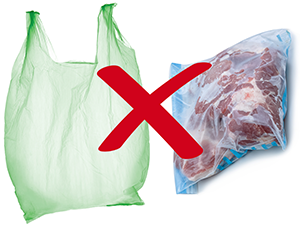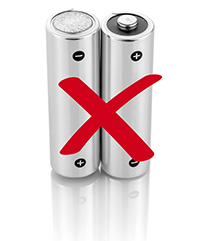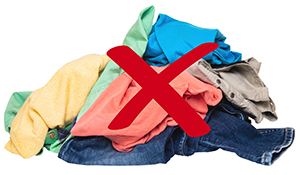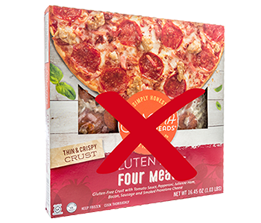To protect the environment and reduce waste, it's important to learn how to recycle right. With so many items to sort, it can be confusing to know what is and isn't recyclable. If you recycle at home, check the list below to make sure you're recycling right. It won't take long, but it will make a difference for the environment!
Know before you throw. Always keep these five items out of your household recycling bin.
1. Plastic bags and plastic wrap
 Plastic bags, produce bags, plastic wrap (e.g., cling wrap, dry cleaner bags and the plastic packaging for toilet paper and paper towels)
Plastic bags, produce bags, plastic wrap (e.g., cling wrap, dry cleaner bags and the plastic packaging for toilet paper and paper towels)
Why it doesn't belong
Plastic bags and wrap are not recycled when you put them in your curbside bin, and they can also cause other recyclable materials to get thrown out. Plastic bags and plastic wrap get wound up in the machinery at the recycling center and can cause severe, expensive damage. The best place to put them is in the garbage.
What else can I do?
- Bring reusable bags when shopping, and keep them in a place where they'll get used, like your car or your kitchen.
- You can help reduce waste by reusing plastic bags you already have. If you reuse them even once, you'll end up using half as many.
- When possible, buy items with little or no plastic packaging and buy bulk foods
2. Batteries
 All batteries—rechargeable and single-use, batteries in electronics and musical greeting cards
All batteries—rechargeable and single-use, batteries in electronics and musical greeting cards
Why it doesn't belong
Batteries can cause fires, burns, and other environmental damage when not disposed of properly. Take them to a hazardous waste facility, a collection event or call 1-800-732-9253 to find other disposal options. Never place batteries in the recycling bin.
What else can I do?
- Buy rechargeable batteries or consider alternatives to battery-operated products.
- Explore options to recycle batteries, by visiting Call2Recycle's website.
3. Clothing, textiles and fabric
 Clothing and curtains
Clothing and curtains
Why it doesn't belong
Clothing does not belong in your recycling bin, and will be thrown away if it arrives at a recycling facility. Textiles are commonly made by combining many different materials, which makes them challenging to separate and recycle. The best place to take clothing that is still wearable is a donation center, such as a thrift store. If it's no longer usable, the best place is in the garbage (or check your local thrift store for recycling options).
What else can I do?
Choose quality clothes that save money, last longer and reduce waste. Poorly made clothes wear out quickly, clutter closets and end up in landfills. Learn more from our Make Every Thread Count campaign.
- Create a thoughtful closet by buying long-lasting and timeless pieces. Mend your clothes to extend their life, and use donation programs to dispose of unwanted items.
- Check with your local thrift store to see if they can accept your clothing, shoes, and other wardrobe items for recycling.
4. StyrofoamTM
 Packing peanuts, blocks, to-go boxes and containers
Packing peanuts, blocks, to-go boxes and containers
Why it doesn't belong
Styrofoam products are not accepted in curbside recycling programs, because they are difficult to sort from other materials and often break into small pieces, ending up as litter in our open spaces, rivers and oceans. The best place to put Styrofoam is in the garbage.
What else can I do?
- Some businesses collect Styrofoam for reuse and recycling. Contact your local government to see if there are any recycling options in your area.
5. Frozen food boxes
 Ice cream boxes, butter boxes and microwavable meals
Ice cream boxes, butter boxes and microwavable meals 
Why it doesn't belong
Frozen food boxes and other paper packaging intended for the refrigerator or freezer (like butter boxes and ice cream containers) often have a plastic coating, which keeps them from falling apart (which is a good thing), but makes them unrecyclable at a paper mill. The best place for frozen food boxes, and other coated paperboards that go in the refrigerator or freezer, is in the garbage.
Here are some other items that are commonly found at Oregon recycling facilities that don't belong.
Any item that’s accepted for recycling in your area that still contains food or liquids
Why it doesn’t belong
Put only empty, clean and dry items in your recycling bin. When containers with food or liquid residue are placed in a recycling bin, they can ruin an entire truckload of otherwise good paper and cardboard that could have been recycled.
What else can I do?
- Recyclable items don’t have to be dishwasher clean. Empty them out, give it a quick rinse, shake off the water and voila! You are good to go!
- Use a spoon, spatula or paper towel to scrape food waste into your compost bucket or trash. Then save the container until you are done with the dishes and use your dirty dishwater. A quick swish or rinse with cold water will usually do the trick. After you rinse it out, shake off the water so other items won’t get wet and throw them in your bin!
Items that can “tangle” machinery
Why it doesn’t belong
Hoses, wires, chains and electric cords can tangle themselves around other materials and machinery, which can cause extensive damage. Do not put these items in your recycling bin.
What else can I do?
- Extend the life of your hose by investing in a rubber one – they are more resistant to kinks and holes.
- If you live in an area subject to harsh winters, bring your hose inside before snowfall to preserve its life.
Coffee cups and restaurant take-out boxes
Why it doesn’t belong
To-go coffee cups and other to-go food containers are not accepted in recycling programs, because they are coated with plastic or wax that makes it difficult to separate from paper in the recycling process. These items should be put in the garbage.
What else can I do?
- Reusable coffee mugs and water bottles are a great, low-waste option for on-the-go.
Bottles and jars
Why it doesn’t belong
Recycle glass in a separate container. Never mix glass with paper, plastic or metal recyclables. Glass mixed with other items can break and contaminate other recyclables, making them difficult or impossible to recycle.
What else can I do?
Envelopes with bubble wrap inside
Why it doesn’t belong
Padded and plastic shipping envelopes cannot be recycled at home. These items are made from multiple materials, which are difficult and labor-intensive to separate. The best place for padded and plastics shipping envelopes is in the trash (unless you can reuse them!).
What else can I do?
- To avoid receiving more shipping envelopes, see if you can reuse, repair or borrow what you are looking for. Look into local shopping options before ordering online.
- If you’re sending something, try reusing any envelopes you may already have before buying a new one.
Want to know what you can recycle at home?
Check out your city, county or recycling service provider's website to see what items belong in your curbside collection service. In the greater Portland area (Clackamas, Multnomah and Washington counties), you can visit RecycleOrNot.org or call the Metro Recycling Information hotline at 503-234-3000.